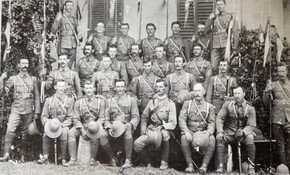WHITNEY, William Henry
| Service Number: | 944 |
|---|---|
| Enlisted: | Not yet discovered |
| Last Rank: | Trooper |
| Last Unit: | New South Wales Lancers |
| Born: | Not yet discovered |
| Home Town: | Not yet discovered |
| Schooling: | Not yet discovered |
| Occupation: | Not yet discovered |
| Memorials: |
Boer War Service
| 1 Oct 1899: | Involvement Trooper, 944, New South Wales Lancers |
|---|
Help us honour William Henry Whitney's service by contributing information, stories, and images so that they can be preserved for future generations.
Add my storyBiography contributed by Aubrey Bairstow
The New South Wales Lancers were formed as the Sydney Light Horse in March 1895.
William Henry Whitney from Lismore was born in 1878.
He formed part of the 3rd draft of the NSW Lancers which arrived in Capetown on 19 March 1900, serving in 4th Squadron.
The NSW Lancers were attached to General French's 1st Cavalry Brigade until 25 October 1900, when their term of engagement was up and the New South Wales Government desperately needed them at home to take part in the celebration of the new Australian Commonwealth. The Squadron became involved in a strenuous campaign of continuous movement. They were fortunate in serving under the man who had lately been their brigadier at Aldershot.
At this stage of the war, British prestige was in the balance. The Boers had successfully attacked British territory. On the east they beleaguered Ladysmith and Natal, and on the west cut off Kimberley, thus forcing their will on the defending armies as they arrived, while moving commandos across country as they wished. In the centre they advanced down the main railway line, and had they bypassed the junctions in the move south, Cape Town would have had to be defended.
Men of the Richmond River area from the 3rd Draft NSW Lancers, which includes Whitney
On 19 November the squadron arrived at Naauwpoort, which was threatened, and next day General French arrived from Cape Town and Natal. The garrison here numbered only 945 with two 9 pounder muzzle-loading guns. It consisted of: half battalion of the Berkshires; half battalion of the Black Watch: 25 Cape Police, and NSW Lancers divided into two troops of about 20 each. One troop patrolled 20 kilometres north under Captain Cox, the other entrained at 05:45 hrs and reconnoitred as far as Rensburg. All returned. The railway line nearer De Aar had been blown up, and 25 men were detailed to cover the repair party.
On the 23rd Lieutenant Osborne's troop took part at the battle of Belmont, and on the same day a troop entrained at Naauwpoort, detrained at Arundel and patrolled in that neighbourhood, meeting the enemy. Daily reconnaissance and minor patrol engagements continued here for the next few days, as Boers estimated at 300 held an advanced post on Arundel Hills. When the Boers vacated Arundel, however, General French had insufficient troops to move up. Meantime, Lieutenant Osborne's . troop had taken part in the battles of Graspan and Modder River.
The Cavalry Division moved off to the Battle of Poplar Grove. Marching and fighting from Abraham's Kraal to Driefontein, the 1st Brigade was the first to locate and engage the enemy. Later, a wide flank attack by the brigade took a hill under heavy fire, and for that day's work a clasp was issued. On March 13 the squadron formed part of an investing ring around Bloemfontein. This town surrendered after Major Weston had blown up the railway to the north and cut the town off from Pretoria.
It was at this time that the NSW. Lancers lost a lot of men from enteric fever. Two men died: Corporal Harkus and Trooper Fetting. A number of others contracted the disease in varying degrees of severity: Lieutenant Roberts and Troopers Akers, Brady, Haken, Knight, Lee, O. L. Milling, T. Morris, K. McPherson, Stratford, Vernon, Wilks, Waddell, Whitney and J. Watts. Whitney survived.
The NSW Lancers returned to Australia in late 1900.
William Whitney had no further overseas military service and died in 1960 and is buried in Sydney.









